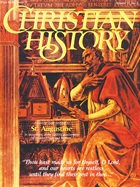With his natural brilliance, his training in rhetoric, and his position of church leadership, Augustine found himself the polemical leader in the church of his day. From his conversion to the time of his death, Augustine battled a succession of “isms” or schisms: first Manichacism, then Donatism, then Pelagiariism.
Manichacism
Manichaeism took its name from its founder, Mani, a Persian born around 216 A.D. The Manichees taught a basic dualism in nature: light and darkness were co-eternal, hostile systems in conflict with each other. Good was passive, darkness and evil were active.
As a gnostic religion, Manichacism appealed to the reason. For nine years Augustine followed the Manichees, but he gradually began to see their errors. When Faustus, reputedly the most brilliant of the Manichees, failed to answer his questions, Augustine’s faith in the Manichees was irrevocably shaken.
Because he had been one of them and then was disillusioned, his opposition to the Manichees was that much stronger after his conversion. Much of his writing and speaking was directed against the Manichees. In Hippo, when he publicly debated the Manichee Fortunatus, Augustine so humiliated the man that he left the city and never returned.
Donatism
Donatism was more a localized and political threat. Early in Constantine’s reign, the Donatists had withdrawn from the Catholic church for both political and doctrinal reasons. They said that during the recent persecution by emperor Diocletian, many of the Catholic leaders had betrayed the church. Such traitors did not deserve to remain as church leaders, they said.
The main disputing was in Carthage, where the Donatists claimed that the Catholic bishop had been ordained by a traitor, and thus his priesthood was invalid. So they set up their own “pure” bishop in Carthage —Donates, for whom they were named.
The Donatists held that they alone were the true church, and insisted on rigorous church discipline and excommunication of all members they deemed “unworthy.” Their issue was separation: they believed the church was an exclusive community, and they were determined to keep it so. One faction of the group, called “circumcellions,” went so far as to travel around the country violently terrorizing the traditional Catholic churches.
From 393 on, Augustine took the offensive against the Donatist church. His contempt for them was obvious: “The clouds roll with thunder, that the house of the Lord shall be built throughout the earth; and these frogs sit in their marsh and croak ‘We are the only Christians’!”
The schism continued, and by order of the emperor the matter was brought to Carthage for arbitration in 411. Augustine was present at the council as one of the chief speakers. The controversy was settled in favor of the Catholics.
One result of the controversy with the Donatists was the development of Augustine’s doctrine of the church: that the essence of the church is in the union of the whole church with Christ, not in the personal character of certain select Christians.
Pelagianism
No sooner had the Donatist controversy been settled than the battle against Pelagianism started up. Its significance lies in it leading Augustine to develop his doctrine of grace.
Pelagius, the founder of the movement, was a 4th-century British monk who rejected the idea of original sin. The tendency to sin is man’s own free choice, he insisted, and not inherited from Adam. Following this reasoning, there is no need for divine grace; man must simply make up his mind to do the will of God.
The church excommunicated Pelagius in 417, but his banner was carried on by Julian, the bishop of Eclanum, whom Augustine refuted in detail in his volumes Against Julian.
The Pelagian heresy was officially condemned at the Council of Ephesus in 431, one year after Augustine’s death.
Copyright © 1987 by the author or Christianity Today/Christian History magazine.
Click here for reprint information on Christian History.

Support Our Work
Subscribe to CT for less than $4.25/month





























